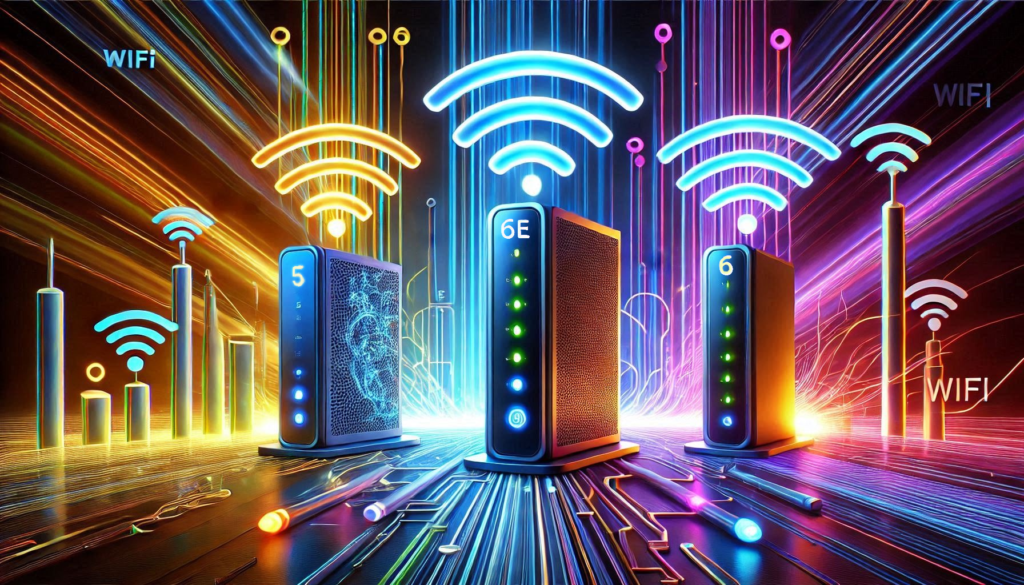
WiFi technology is advancing, and many users wonder which standard to choose: WiFi 5 vs WiFi 6 vs WiFi 6E. Each option has its own strengths. Choosing the right one depends on your devices, needs, and budget. Whether you’re upgrading your router or buying a new device, understanding the differences can help you make the best decision.
Why WiFi 5 Still Matters
Even though WiFi 5 (802.11ac) was introduced in 2013, it remains a reliable and cost-effective option for many users.
- Affordable Option
WiFi 5 routers are budget-friendly while still delivering solid performance for everyday activities like browsing and HD streaming. - Wide Device Compatibility
Most devices in use today still rely on WiFi 5, including older laptops, TVs, and smartphones. Although WiFi 6 routers are backward compatible, older devices won’t experience the full benefits of the newer standard. - Comparable Range to WiFi 6
If expanding coverage is your priority, a high-quality WiFi 5 router can often outperform low-end WiFi 6 alternatives at a fraction of the cost.
WiFi 6: Faster, Smarter, and More Efficient
WiFi 6 (802.11ax) delivers significant improvements in speed, efficiency, and network management, making it ideal for homes with multiple connected devices.
- Real-World Speed Boosts
With speeds reaching up to 1 Gbps on compatible devices, WiFi 6 is perfect for gigabit internet plans, 8K streaming, and large file transfers. - Better Network Efficiency with OFDMA
WiFi 6 uses OFDMA (Orthogonal Frequency-Division Multiple Access), allowing routers to communicate with multiple devices simultaneously, reducing congestion and latency. This is especially valuable for smart homes and busy networks. - Improved Battery Life
With Target Wake Time (TWT), WiFi 6 reduces power usage for devices by scheduling wake-up times, leading to longer battery life for smartphones, tablets, and IoT devices. - Future-Proof Your Network
As internet speeds increase and more smart devices enter homes, WiFi 6 ensures your network stays fast and efficient for years to come.
WiFi 6E: Unlocking the 6GHz Band
WiFi 6E builds on WiFi 6 by introducing the 6GHz frequency band, offering unparalleled speed and reduced congestion.
- More Bandwidth, Less Interference
The 6GHz band provides wider channels (up to 160 MHz), perfect for activities like:- Streaming 8K video
- Low-latency VR and AR
- Lag-free online gaming
- Higher Speeds, Shorter Range
While the 6GHz band delivers blazing-fast speeds, its range is shorter compared to 2.4GHz and 5GHz bands. WiFi 6E works best for devices located close to the router, such as PCs, gaming consoles, and smart TVs. - Growing Device Support
Initially limited to premium devices, WiFi 6E is becoming more accessible as smartphones, laptops, and gaming systems adopt the technology. - Higher Costs
WiFi 6E routers are still pricey, so unless you own compatible devices and need the absolute fastest speeds, a strong WiFi 6 setup might be a smarter investment.
WiFi 5, WiFi 6, and WiFi 6E: Device Compatibility
- WiFi 5: Compatible with older devices like the iPhone 6, iPhone 7, Samsung Galaxy S7, and most laptops and smart TVs.
- WiFi 6: Works with newer devices like the iPhone 11 and later, Samsung Galaxy S10 and later, laptops with Intel’s Wi-Fi 6 chip, and some smart home devices.
- WiFi 6E: Supported by premium devices like the iPhone 13 and later, Samsung Galaxy S21, and newer gaming consoles, but also becoming more widespread.
WiFi 5 vs WiFi 6 vs WiFi 6E: Quick Comparison
| Feature | WiFi 5 | WiFi 6 | WiFi 6E |
|---|---|---|---|
| Frequency Bands | 5GHz | 2.4GHz & 5GHz | 2.4GHz, 5GHz & 6GHz |
| Max Speed | 3.5 Gbps | 9.6 Gbps | 9.6 Gbps |
| Device Efficiency | Limited | Excellent | Excellent |
| Bandwidth | Narrow | Wide | Widest (6GHz) |
| Congestion Handling | Moderate | Good | Best |
| Cost | Affordable | Moderate | Expensive |
Which WiFi Standard Should You Choose?
- WiFi 5: Perfect for budget-conscious users with basic needs.
- WiFi 6: The best balance of speed, efficiency, and future-proofing for most homes.
- WiFi 6E: Ideal for cutting-edge performance if you have compatible devices and need ultra-fast speeds.
For most users, WiFi 6 is more than enough to meet the demands of modern internet usage, providing a strong, fast, and future-proof network for homes and small businesses. However, if you have a lot of devices or demand the very highest performance, WiFi 6E might be worth considering.
To maximize the benefits, ensure both your router and devices support the WiFi standard you choose. Upgrading only the router won’t deliver the full performance boost unless your devices can keep up.
But wait, there’s even more! There’s another WiFi standard emerging that’s even faster than WiFi 6e—WiFi 7. If you’re curious about how WiFi 7 compares to this ones, click here to learn more about this next-generation technology.

1 thought on “WiFi 5 vs WiFi 6 vs WiFi 6E: What You Need to Know in 2025”